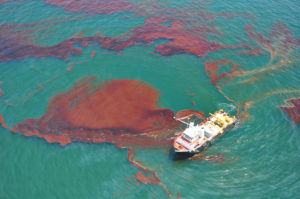 Oil spills are one of the worst ecological disasters that can strike an area. They leave the water and coastlines a mess, and they cause great harm to wildlife trapped in the oily gunk. The Exxon Valdez incident caused damage to Alaska for years. The BP Deepwater Horizon incident allowed almost five million barrels of oil to flow into the Gulf of Mexico. Each year, it is estimated that oil spills release 7,000 tons of oil into the waterways of the world.
Oil spills are one of the worst ecological disasters that can strike an area. They leave the water and coastlines a mess, and they cause great harm to wildlife trapped in the oily gunk. The Exxon Valdez incident caused damage to Alaska for years. The BP Deepwater Horizon incident allowed almost five million barrels of oil to flow into the Gulf of Mexico. Each year, it is estimated that oil spills release 7,000 tons of oil into the waterways of the world.
There are means available to help clean up oil spills. Clean up crews usually use either polypropylene fibers or polyurethane foam to get the clean up jobs accomplished. The drawback to using these methods is the cost.
Scientists working together at the Institute of Molecular Medicine, the Flinders Institute and Cambridge University have developed a new way to help clean up oil in the water that is much less expensive than the traditional methods. Scientists working at these institutions have developed a compound that is made from sulfur and canola oil. It is designed to have the same action as a sponge. The product is known as a low-density polysulfide.
When the low-density polysulfide is placed into the oil contaminated water, it immediately begins to absorb the oil. The substance can be netted out of the water bringing the oil contamination up out of the water leaving the water significantly cleaner.
Another benefit of this new technology is its reuseability. The substance can be wrung out like a sponge allowing it to be placed back into the oily water to draw out more of the oil.
Over the next year, scientists will work with governments and manufacturers to see if this new product can be produced in sufficient quantities to be used in major oil spills. The hope is that this new technology will be able to be used in areas where traditional methods are not practical due to problems with transportation or overall cost.



